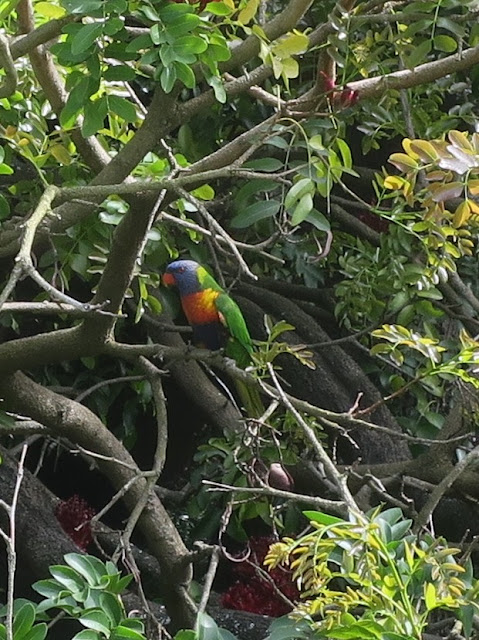While in the Royal Botanic Gardens Melbourne a couple of weeks ago, my attention was caught by the racket made by a large number of Rainbow Lorikeets squawking while feasting in one particular tree.
The tree turned out to be a South African Weeping Boer-bean, Schotia brachypetala. Interestingly, the "Weeping" part of its name refers to the copious amounts of nectar the flowers produce. No wonder the Lorikeets seemed to be going crazy.
Earlier in the day I held the final 2021 class for my Melbourne students at Margaret's house. As only five students were able to attend I decided that we should make a Renka. This is a collaborative ikebana, progressively built up by a group. Each participant, in succession, has a limited time to make their ikebana in response to what has been created before them. They can take their inspiration from the line, movement, colour or feel of the developing ikebana.
The idea of Renka was developed by the third Sogetsu Iemoto, Hiroshi Teshigahara. It is modelled on the classical, linked poetry form called Renga, when brief stanzas of poetry are improvised in response to a previous stanza.
Above is our Renka as it finally evolved. I began the process as it was an unfamiliar exercise for the students. We had all brought material for a Christmas ikebana but had to choose an unfamiliar vessel from Margaret's collection of vases. With a maximum of 15 minutes working time I began by arranging a large dried stem of Kiwi Vine, three stems of Alstromeria psittacina, and a small sprig of variegated Holly, Ilex aquifolium in my chosen vessel. It is in the small black vessel made of three ceramic loops, just to the right of the centre.
Just to the left Margaret added a strong curving line of variegated Miscanthus that leans to the right, teamed with hot pink Begonia, red crucifix orchid, grape vine leaves and some red Christmas baubles. Marcia added the strong line of Christmas lily on the right with a curving branch of pine. Eugenia added long-needle pine and a black zig-zagging branch line with Christmas baubles on the far left. At the back lefthand side Marisha added a branch of pine that curves to the left, some white flowers and red berries. On the righthand side at the back Jacqueline added the strong line of split New Zealand flax that leans to the left and a mass of pale green carnations.
One of the things that became apparent in the process was that the "less is more" principle is necessary to create harmony and to prevent the final work looking over-loaded. Unfortunately, the top of the work had to be cropped a little because it extended above a black overhead light pelmet.
Greetings from Christopher
18th December 2021




Thank you for giving us so much useful information that we can use. If I had to choose, this is one of the best essays I have ever read. My absolute favorite of your blogs is this one. Basically what I was looking for. I hope you keep making great things.office relocation melbourne
ReplyDelete